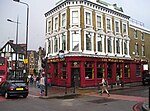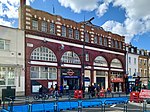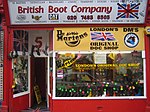The Camden Head
1787 establishments in EnglandBuildings and structures in the London Borough of CamdenCamden TownFormer music venues in LondonMusic venues in London ... and 3 more
Pubs in the London Borough of CamdenTourist attractions in the London Borough of CamdenUse British English from March 2014

The Camden Head is one of the oldest pubs in Camden, London, England having been established in 1787. It is also a former music venue and hosts comedy events.
Excerpt from the Wikipedia article The Camden Head (License: CC BY-SA 3.0, Authors, Images).The Camden Head
Camden High Street, London Chalk Farm (London Borough of Camden)
Geographical coordinates (GPS) Address Nearby Places Show on map
Geographical coordinates (GPS)
| Latitude | Longitude |
|---|---|
| N 51.5373 ° | E -0.14112 ° |
Address
German Doner Kebab
Camden High Street 102
NW1 0LU London, Chalk Farm (London Borough of Camden)
England, United Kingdom
Open on Google Maps









